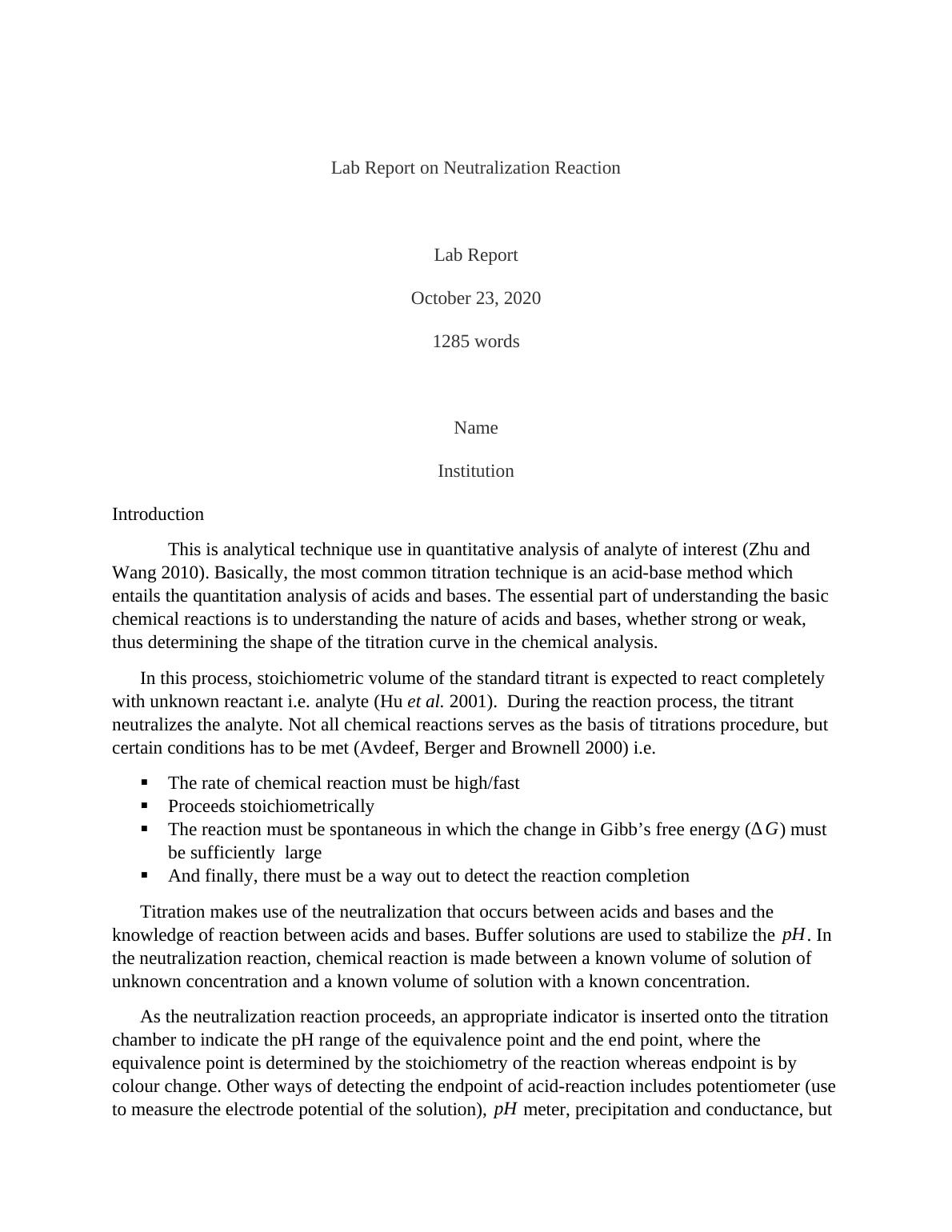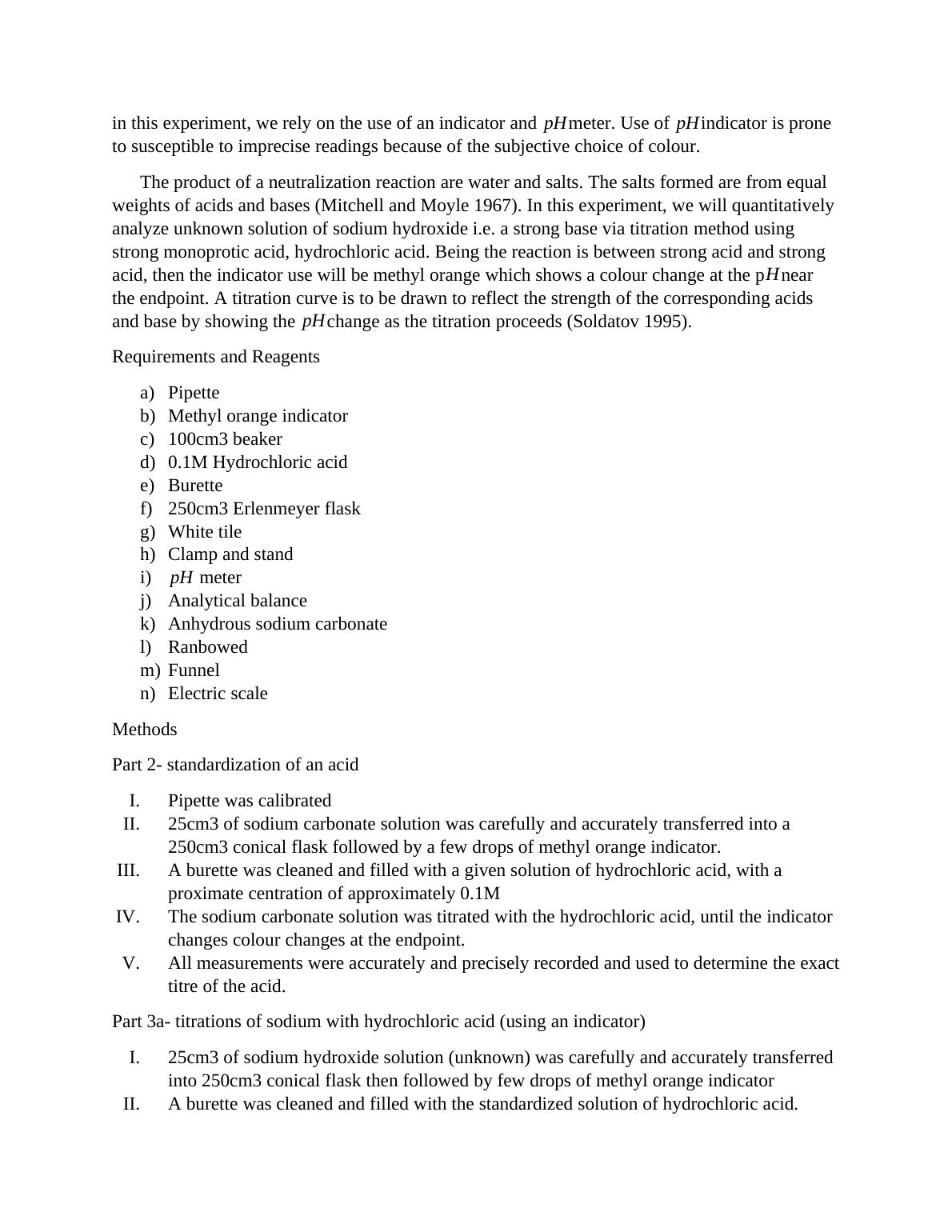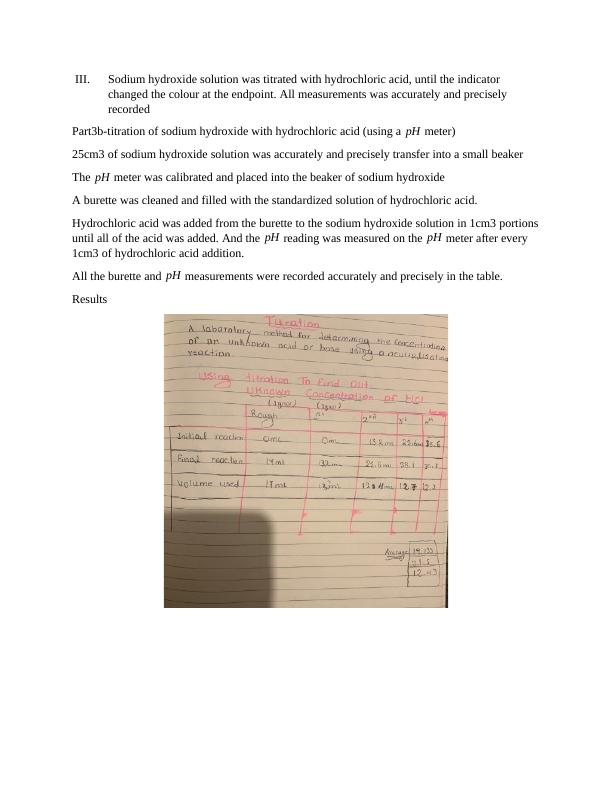Lab Report on Neutralization Reaction 2022
Added on 2022-08-26
7 Pages1698 Words24 Views
Lab Report on Neutralization Reaction
Lab Report
October 23, 2020
1285 words
Name
Institution
Introduction
This is analytical technique use in quantitative analysis of analyte of interest (Zhu and
Wang 2010). Basically, the most common titration technique is an acid-base method which
entails the quantitation analysis of acids and bases. The essential part of understanding the basic
chemical reactions is to understanding the nature of acids and bases, whether strong or weak,
thus determining the shape of the titration curve in the chemical analysis.
In this process, stoichiometric volume of the standard titrant is expected to react completely
with unknown reactant i.e. analyte (Hu et al. 2001). During the reaction process, the titrant
neutralizes the analyte. Not all chemical reactions serves as the basis of titrations procedure, but
certain conditions has to be met (Avdeef, Berger and Brownell 2000) i.e.
The rate of chemical reaction must be high/fast
Proceeds stoichiometrically
The reaction must be spontaneous in which the change in Gibb’s free energy (∆ G) must
be sufficiently large
And finally, there must be a way out to detect the reaction completion
Titration makes use of the neutralization that occurs between acids and bases and the
knowledge of reaction between acids and bases. Buffer solutions are used to stabilize the pH. In
the neutralization reaction, chemical reaction is made between a known volume of solution of
unknown concentration and a known volume of solution with a known concentration.
As the neutralization reaction proceeds, an appropriate indicator is inserted onto the titration
chamber to indicate the pH range of the equivalence point and the end point, where the
equivalence point is determined by the stoichiometry of the reaction whereas endpoint is by
colour change. Other ways of detecting the endpoint of acid-reaction includes potentiometer (use
to measure the electrode potential of the solution), pH meter, precipitation and conductance, but
Lab Report
October 23, 2020
1285 words
Name
Institution
Introduction
This is analytical technique use in quantitative analysis of analyte of interest (Zhu and
Wang 2010). Basically, the most common titration technique is an acid-base method which
entails the quantitation analysis of acids and bases. The essential part of understanding the basic
chemical reactions is to understanding the nature of acids and bases, whether strong or weak,
thus determining the shape of the titration curve in the chemical analysis.
In this process, stoichiometric volume of the standard titrant is expected to react completely
with unknown reactant i.e. analyte (Hu et al. 2001). During the reaction process, the titrant
neutralizes the analyte. Not all chemical reactions serves as the basis of titrations procedure, but
certain conditions has to be met (Avdeef, Berger and Brownell 2000) i.e.
The rate of chemical reaction must be high/fast
Proceeds stoichiometrically
The reaction must be spontaneous in which the change in Gibb’s free energy (∆ G) must
be sufficiently large
And finally, there must be a way out to detect the reaction completion
Titration makes use of the neutralization that occurs between acids and bases and the
knowledge of reaction between acids and bases. Buffer solutions are used to stabilize the pH. In
the neutralization reaction, chemical reaction is made between a known volume of solution of
unknown concentration and a known volume of solution with a known concentration.
As the neutralization reaction proceeds, an appropriate indicator is inserted onto the titration
chamber to indicate the pH range of the equivalence point and the end point, where the
equivalence point is determined by the stoichiometry of the reaction whereas endpoint is by
colour change. Other ways of detecting the endpoint of acid-reaction includes potentiometer (use
to measure the electrode potential of the solution), pH meter, precipitation and conductance, but

in this experiment, we rely on the use of an indicator and pHmeter. Use of pHindicator is prone
to susceptible to imprecise readings because of the subjective choice of colour.
The product of a neutralization reaction are water and salts. The salts formed are from equal
weights of acids and bases (Mitchell and Moyle 1967). In this experiment, we will quantitatively
analyze unknown solution of sodium hydroxide i.e. a strong base via titration method using
strong monoprotic acid, hydrochloric acid. Being the reaction is between strong acid and strong
acid, then the indicator use will be methyl orange which shows a colour change at the p H near
the endpoint. A titration curve is to be drawn to reflect the strength of the corresponding acids
and base by showing the pHchange as the titration proceeds (Soldatov 1995).
Requirements and Reagents
a) Pipette
b) Methyl orange indicator
c) 100cm3 beaker
d) 0.1M Hydrochloric acid
e) Burette
f) 250cm3 Erlenmeyer flask
g) White tile
h) Clamp and stand
i) pH meter
j) Analytical balance
k) Anhydrous sodium carbonate
l) Ranbowed
m) Funnel
n) Electric scale
Methods
Part 2- standardization of an acid
I. Pipette was calibrated
II. 25cm3 of sodium carbonate solution was carefully and accurately transferred into a
250cm3 conical flask followed by a few drops of methyl orange indicator.
III. A burette was cleaned and filled with a given solution of hydrochloric acid, with a
proximate centration of approximately 0.1M
IV. The sodium carbonate solution was titrated with the hydrochloric acid, until the indicator
changes colour changes at the endpoint.
V. All measurements were accurately and precisely recorded and used to determine the exact
titre of the acid.
Part 3a- titrations of sodium with hydrochloric acid (using an indicator)
I. 25cm3 of sodium hydroxide solution (unknown) was carefully and accurately transferred
into 250cm3 conical flask then followed by few drops of methyl orange indicator
II. A burette was cleaned and filled with the standardized solution of hydrochloric acid.
to susceptible to imprecise readings because of the subjective choice of colour.
The product of a neutralization reaction are water and salts. The salts formed are from equal
weights of acids and bases (Mitchell and Moyle 1967). In this experiment, we will quantitatively
analyze unknown solution of sodium hydroxide i.e. a strong base via titration method using
strong monoprotic acid, hydrochloric acid. Being the reaction is between strong acid and strong
acid, then the indicator use will be methyl orange which shows a colour change at the p H near
the endpoint. A titration curve is to be drawn to reflect the strength of the corresponding acids
and base by showing the pHchange as the titration proceeds (Soldatov 1995).
Requirements and Reagents
a) Pipette
b) Methyl orange indicator
c) 100cm3 beaker
d) 0.1M Hydrochloric acid
e) Burette
f) 250cm3 Erlenmeyer flask
g) White tile
h) Clamp and stand
i) pH meter
j) Analytical balance
k) Anhydrous sodium carbonate
l) Ranbowed
m) Funnel
n) Electric scale
Methods
Part 2- standardization of an acid
I. Pipette was calibrated
II. 25cm3 of sodium carbonate solution was carefully and accurately transferred into a
250cm3 conical flask followed by a few drops of methyl orange indicator.
III. A burette was cleaned and filled with a given solution of hydrochloric acid, with a
proximate centration of approximately 0.1M
IV. The sodium carbonate solution was titrated with the hydrochloric acid, until the indicator
changes colour changes at the endpoint.
V. All measurements were accurately and precisely recorded and used to determine the exact
titre of the acid.
Part 3a- titrations of sodium with hydrochloric acid (using an indicator)
I. 25cm3 of sodium hydroxide solution (unknown) was carefully and accurately transferred
into 250cm3 conical flask then followed by few drops of methyl orange indicator
II. A burette was cleaned and filled with the standardized solution of hydrochloric acid.

III. Sodium hydroxide solution was titrated with hydrochloric acid, until the indicator
changed the colour at the endpoint. All measurements was accurately and precisely
recorded
Part3b-titration of sodium hydroxide with hydrochloric acid (using a pH meter)
25cm3 of sodium hydroxide solution was accurately and precisely transfer into a small beaker
The pH meter was calibrated and placed into the beaker of sodium hydroxide
A burette was cleaned and filled with the standardized solution of hydrochloric acid.
Hydrochloric acid was added from the burette to the sodium hydroxide solution in 1cm3 portions
until all of the acid was added. And the pH reading was measured on the pH meter after every
1cm3 of hydrochloric acid addition.
All the burette and pH measurements were recorded accurately and precisely in the table.
Results
changed the colour at the endpoint. All measurements was accurately and precisely
recorded
Part3b-titration of sodium hydroxide with hydrochloric acid (using a pH meter)
25cm3 of sodium hydroxide solution was accurately and precisely transfer into a small beaker
The pH meter was calibrated and placed into the beaker of sodium hydroxide
A burette was cleaned and filled with the standardized solution of hydrochloric acid.
Hydrochloric acid was added from the burette to the sodium hydroxide solution in 1cm3 portions
until all of the acid was added. And the pH reading was measured on the pH meter after every
1cm3 of hydrochloric acid addition.
All the burette and pH measurements were recorded accurately and precisely in the table.
Results

End of preview
Want to access all the pages? Upload your documents or become a member.
Related Documents
Acid-Base Titration Exerciselg...
|7
|1302
|220
Fundamentals of Science - Assignmentlg...
|6
|1279
|263
Analysis of an Antacid Lab 2022lg...
|7
|1670
|27
Practical Experiment for Acid-Base Titrationlg...
|11
|1477
|382
Chemistry Study Materiallg...
|4
|602
|73
